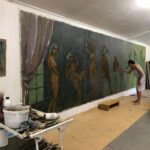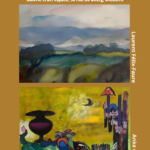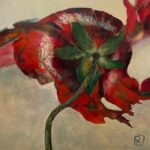Laurent Félix-Faure – “It’s the surprise that counts!”

SOUSPIERRE
What characterizes the Drôme – besides the variety of beautiful landscapes and its excellent climate – making this part of France so appealing are the marks of a rich and exciting human past. No fewer than six hundred castles, an incredible number of Romanesque chapels, churches, cathedrals and monasteries, not to mention the vestiges of Roman, Greek, Celtic and Gallic occupation. Every town and village has many stories to tell. Take the village of Souspierre where I live with my wife Anke de Vries (see her Blog). A logical explanation for its name is that it was built at the foot of a rocky cliff, “sous la pierre or Souspierre” in French meaning under the rock. However, according to some local historians it could well derive from “soupire” (sigh in English) a reminder of the days when brigands waylaid travellers passing through the gorge of the Bridon at the bottom of the hill leaving them bereft and sighing on the roadside.
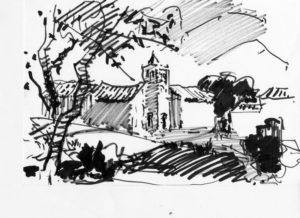
As for visible signs of human presence in Souspierre, high above the little 17th century church with the Lombard tower that was added to it at a later date there is a ruin, a mere rocky outcrop called la Tour Sarrasine. When it was shown to me for the first time it conjured up in my mind Moorish invaders who occupied the region in the 8th century scrutinizing the surrounding area and the plain that stretches all the way down to the Rhône River. Since then I have been told that the ruins are the remains of a lookout tower built by the Knights Hospitaller when they were stationed in the commandery of le Poët Laval in the 12th century. I also recently learned that not far from our place ancient tombs facing the East had been excavated of which the origins are a mystery. All these individuals from the past and perhaps others still to be discovered, have trodden the same land I now live in. Do their spirits continue to roam the valley? I believe they do and I am also convinced that they are part of the atmosphere that perhaps affects my painting. Be that as it may my palette since our arrival has radically changed. The grey hues of the misty North have been replaced by bright and vivid colours that seem to compete in order to convey how I feel in this environment illuminated by the sun and a secular culture.
ART AND I
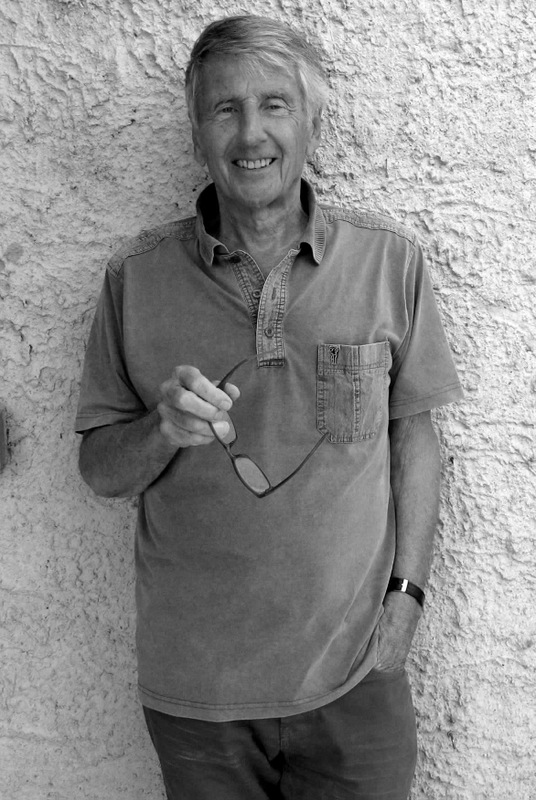 I am not a professional artist who earns a living out of what he or she makes. I never have been, and I realize how fortunate I am not to have to combine and balance the two. Nor is art for me a substitute for ordinary life as it can be for highly talented artists we admire to the extent sometimes of making them unhappy and destroying their personal relationships. I am an amateur and the art I create is not a risky or dangerous business but a source of personal joy that I can also share with those who buy my works. The reason I chose painting above other activities comes, I think, because I am an acute observer of the world around me and to a degree I happen to have the means to recreate on paper and on canvas what I have seen and felt. From early childhood I loved looking at pictures. They had a magical effect on me. I must have been five or six years old when I came across a drawing of a sheep in a story book. I can still remember it very clearly. It was nothing like a sheep: the sausage-like body had a small oval head with triangles for ears and a dot for an eye at one end and a bobtail at the other; and it stood precariously on four sticks. The artist must have been sadly lacking talent but I loved it! In retrospect I realise that the impression this awkwardly drawn animal made on me is what I believe art does to you. To quote Matisse “Exactitude is not the truth.”
I am not a professional artist who earns a living out of what he or she makes. I never have been, and I realize how fortunate I am not to have to combine and balance the two. Nor is art for me a substitute for ordinary life as it can be for highly talented artists we admire to the extent sometimes of making them unhappy and destroying their personal relationships. I am an amateur and the art I create is not a risky or dangerous business but a source of personal joy that I can also share with those who buy my works. The reason I chose painting above other activities comes, I think, because I am an acute observer of the world around me and to a degree I happen to have the means to recreate on paper and on canvas what I have seen and felt. From early childhood I loved looking at pictures. They had a magical effect on me. I must have been five or six years old when I came across a drawing of a sheep in a story book. I can still remember it very clearly. It was nothing like a sheep: the sausage-like body had a small oval head with triangles for ears and a dot for an eye at one end and a bobtail at the other; and it stood precariously on four sticks. The artist must have been sadly lacking talent but I loved it! In retrospect I realise that the impression this awkwardly drawn animal made on me is what I believe art does to you. To quote Matisse “Exactitude is not the truth.”
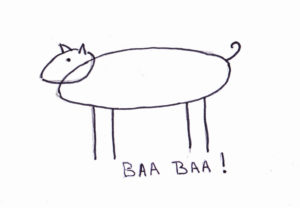
Of course, like so many others I went through the imitative stages of probation during my adolescence devouring comics and making hundreds of sketches featuring cowboys and the like in little animated scenes. I also liked drawing cartoons and showing them to friends. As an adult, although it was far removed from my professional duties, I registered in and followed evening art courses at the Royal Dutch Academy for fine Arts in The Hague where I resided with my family. I am not sure whether what I learned there was useful except for acquiring a few tricks of the trade but I did enter a new and fascinating world that has stayed with me ever since. Quite apart from making my own paintings and perhaps even more so, I developed an eagerness to learn more about the works and lives of other visual artists, both contemporaries and those of the past, and this even led me among other art-related activities to write a number of art books as well as the present Blog series.
With regard to the work I create it really all revolves around landscapes. They are fundamental to my approach to painting as a whole, whether figurative or abstract, in oil and in watercolour. As a child growing up I led a nomadic life, moving from country to country, across a range of very different environments. Somehow these successive landscapes – and the people who lived there – are deeply engrained in my mind and continue to determine many of my perceptual reactions. Coming to live in the Drôme was a blessing. The landscape with its high summits alternating with low lying hills, plains fringed by distant mountain ranges, the blues, the yellows and the ochre, has the multiple facets of those of my itinerant youth. Call it gut recognition, I draw and paint my present surroundings with all my heart (and even by heart). In this respect all I simply have to do is follow the precept of the German Expressionist painter Emile Nolde that the artist should go ahead and paint first and think afterwards.
Oils
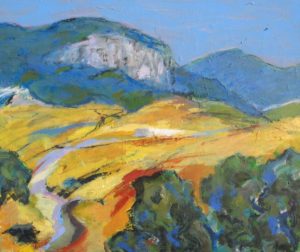
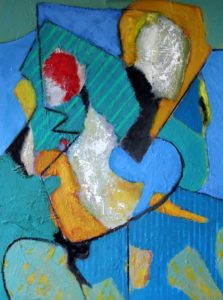 When I first started to paint in oils my attempts were marred by my impatience to finish or simply by the flagging of my attention. I found a simple way to get around the problem by simply immediately making preparatory drawings before going on to paint the subject on canvas but I won’t hesitate to make modifications when I feel like it. This is even more so when I make abstracts that I consider to be a real adventure in painting. Their size mostly ranges between 60 x 80cm and 80 x 100cm. I start off with a few set forms and colours and proceed to modify the initial composition to the extent of vandalizing the painting with criss-cross brush strokes or splotches of paint before starting off all over again until I can stand back and feel satisfied with the result. By doing so I am simply applying Picasso’s precept that every act of creation should begin by an act of destruction. I don’t mind leaving flaws and blemishes in my work, in fact I am wary of paintings that are too finished as I don’t believe in encapsulating emotions. In my mind a painting whether it is figurative or abstract is complete when it reaches the stage that strikes the right chord and makes me feel good.
When I first started to paint in oils my attempts were marred by my impatience to finish or simply by the flagging of my attention. I found a simple way to get around the problem by simply immediately making preparatory drawings before going on to paint the subject on canvas but I won’t hesitate to make modifications when I feel like it. This is even more so when I make abstracts that I consider to be a real adventure in painting. Their size mostly ranges between 60 x 80cm and 80 x 100cm. I start off with a few set forms and colours and proceed to modify the initial composition to the extent of vandalizing the painting with criss-cross brush strokes or splotches of paint before starting off all over again until I can stand back and feel satisfied with the result. By doing so I am simply applying Picasso’s precept that every act of creation should begin by an act of destruction. I don’t mind leaving flaws and blemishes in my work, in fact I am wary of paintings that are too finished as I don’t believe in encapsulating emotions. In my mind a painting whether it is figurative or abstract is complete when it reaches the stage that strikes the right chord and makes me feel good.
Watercolours
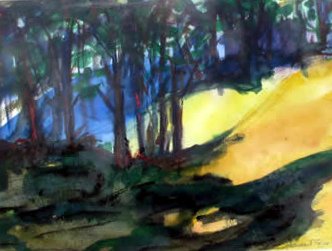
The technique is difficult to master and requires a sure hand but the material is light to carry making it a perfect medium for the traveller I once was. The format I mainly use is 30 x 40cm. In the past I regularly made on the spot spontaneous sketch like recordings in watercolours of the regions and countries I visited. When I look at some of them today, I am surprised at how well I can recall the atmosphere of the place where they were painted, much more than with photos. The watercolours I paint here at home in my studio take a longer time to make. I work at them without pausing and in full concentration until I reach the point of “emotional” recognition. They may represent a particular aspect of my surroundings that has caught my attention but I often depart from the original while I work in order to paint forms and colours that correspond to how I feel, as though I were composing a melody rather than an image of what I see.
Illustrations
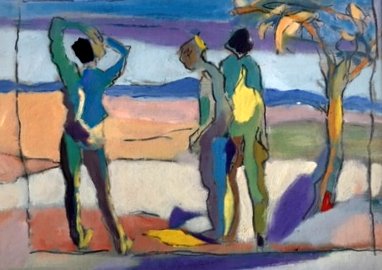
There is a form of free style painting I thoroughly enjoy, a pastime that takes me back to the time of the animated little scenes I used to draw when I was young. I go about it by starting to paint a figure or a landscape off the cuff in whatever stance or form happens to come to me and I then let my brush paint freely until an unexpected development catches my imagination. All I need to do is to finish it off. These improvisations tell a story. Not one I consciously had in mind but an imagery that emerges from some hidden part in me. Knowing beforehand is of no interest to me. “It’s the surprise that counts!”
Posted in: Art
